-
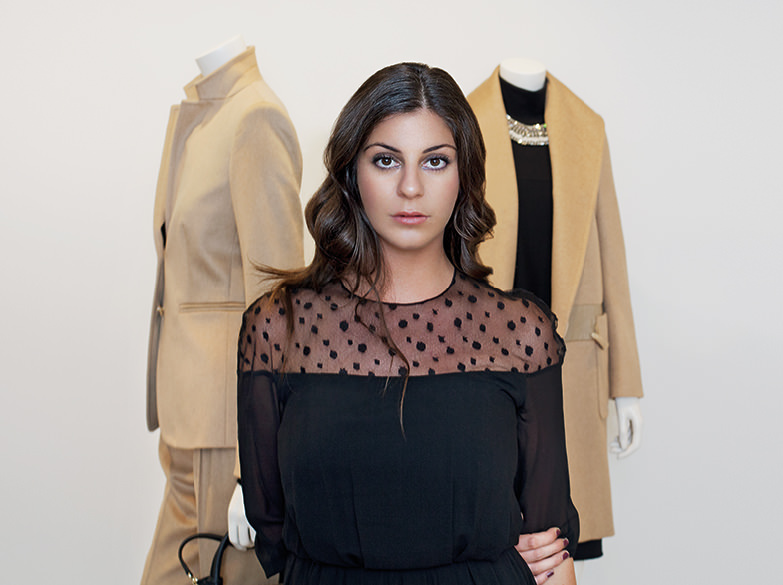
-
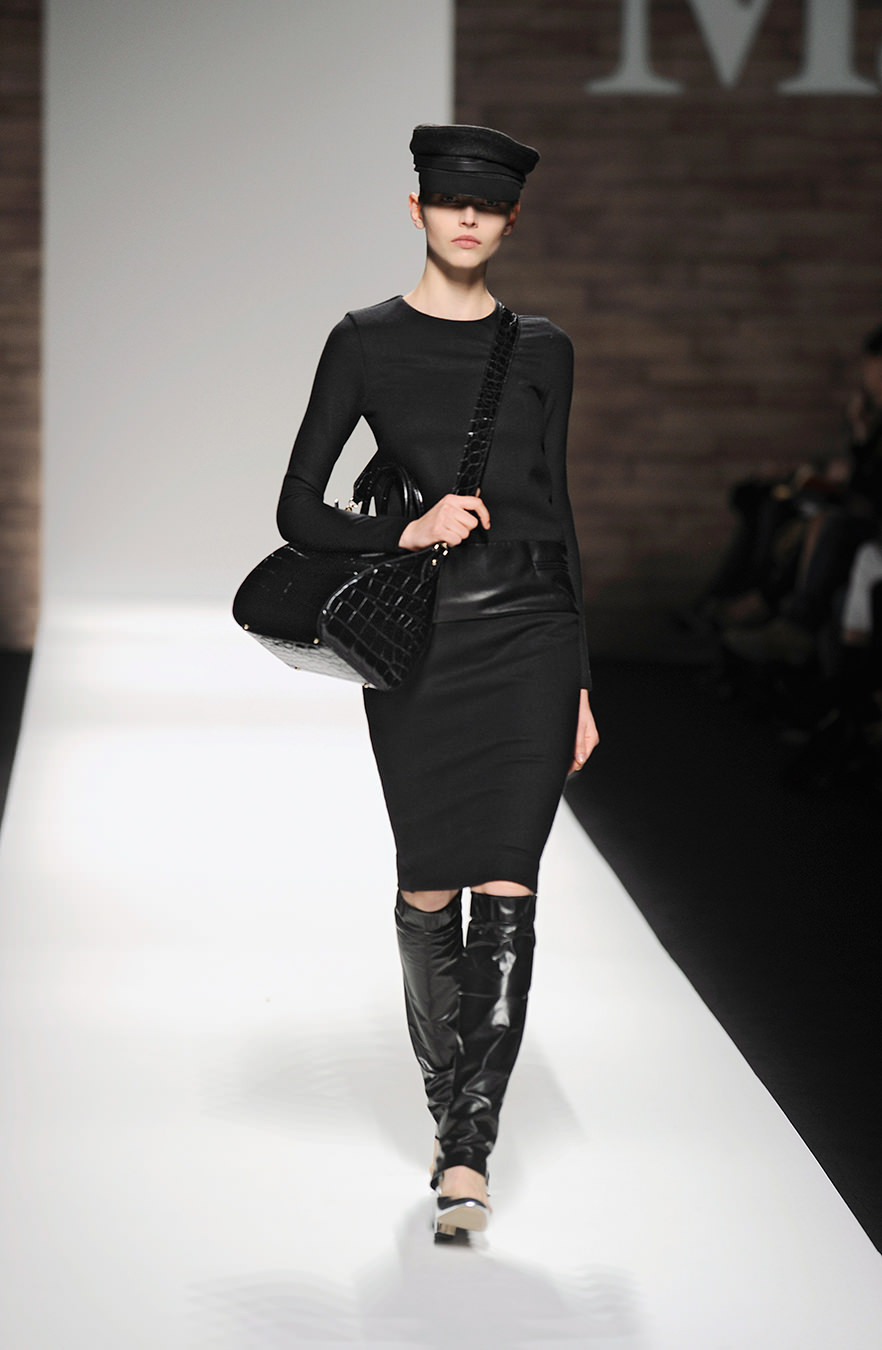
The Max Mara fall/winter 2012 collection.
-
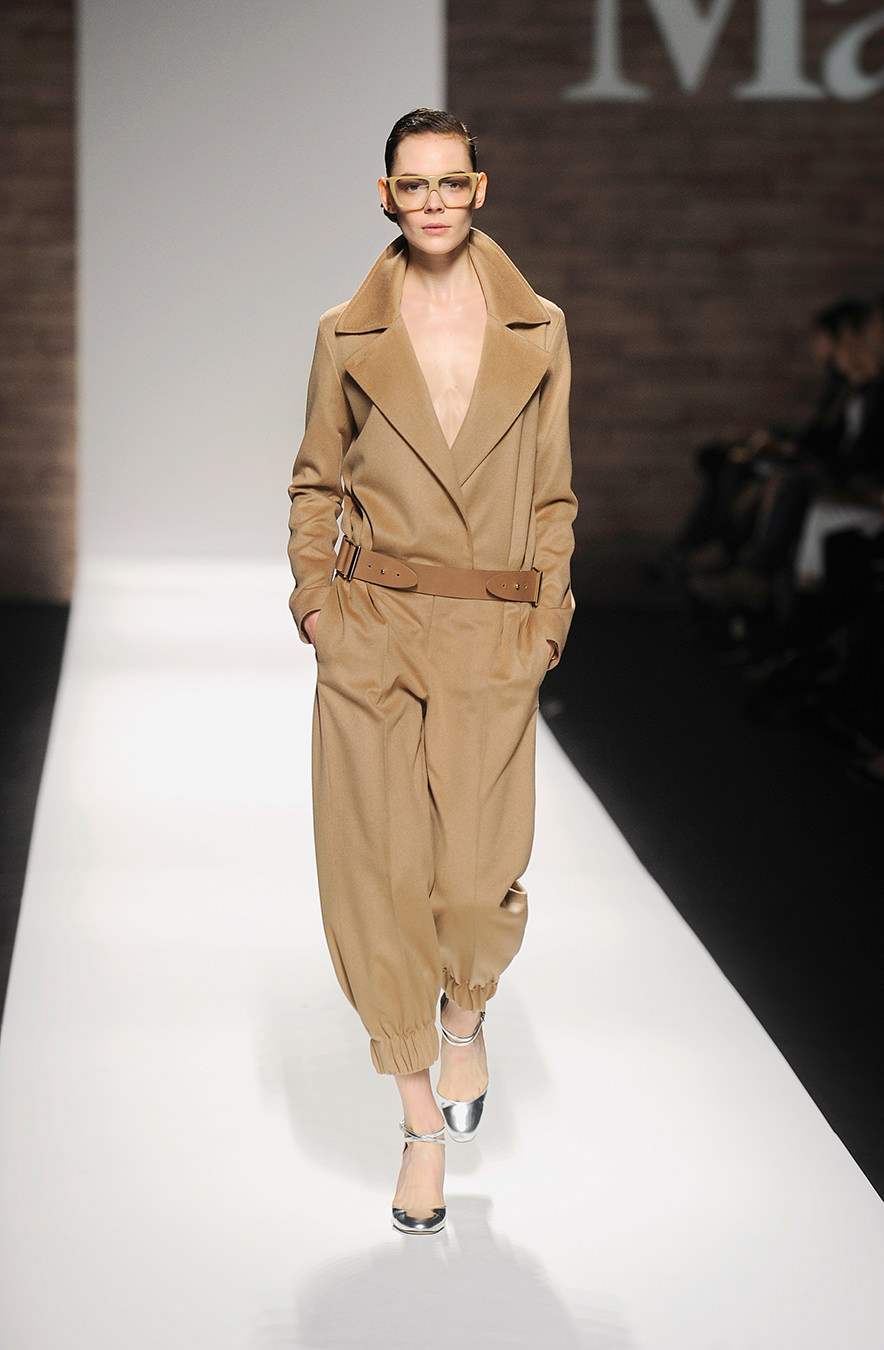
The Max Mara fall/winter 2012 collection.
-
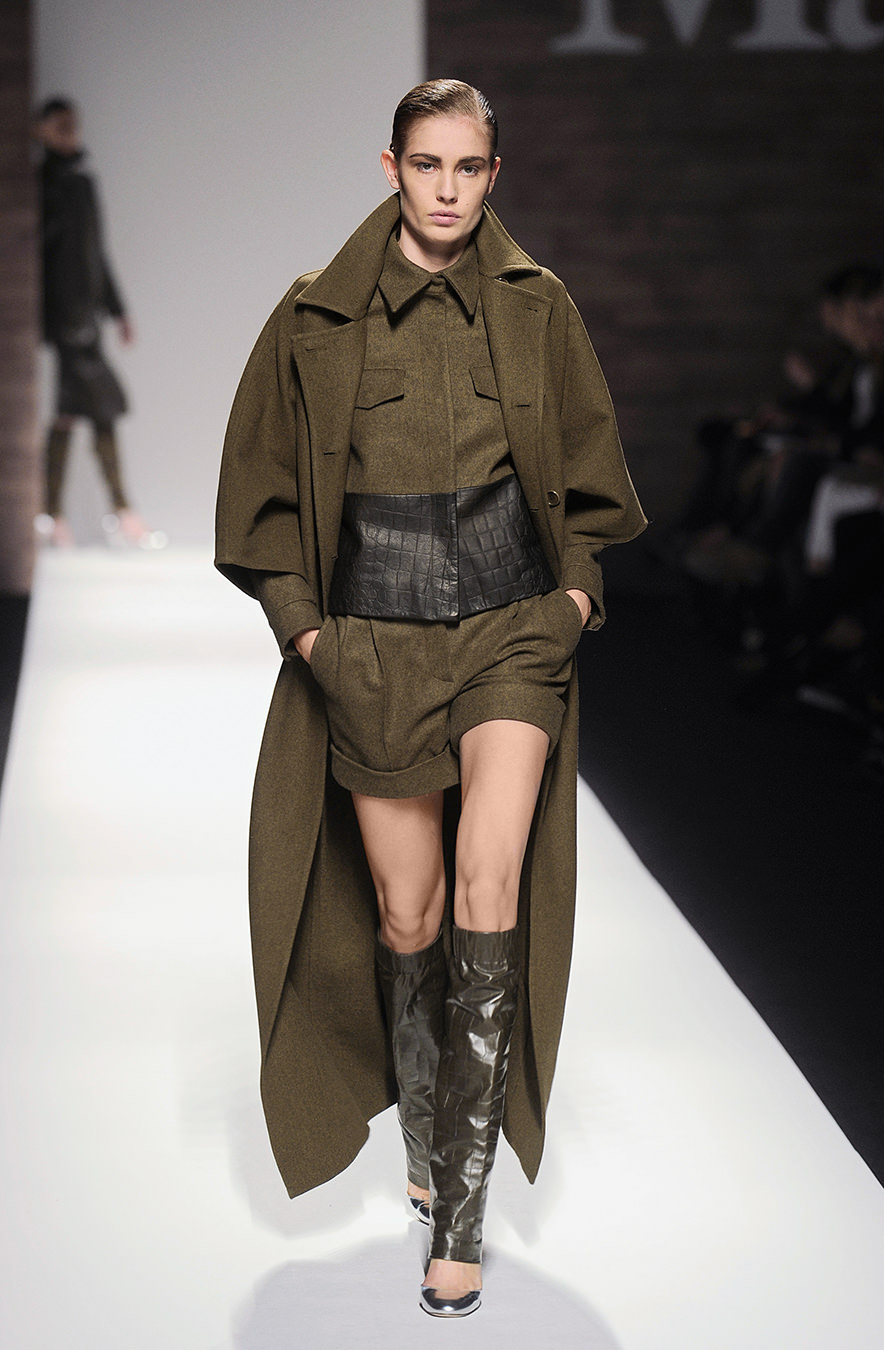
The Max Mara fall/winter 2012 collection.
-
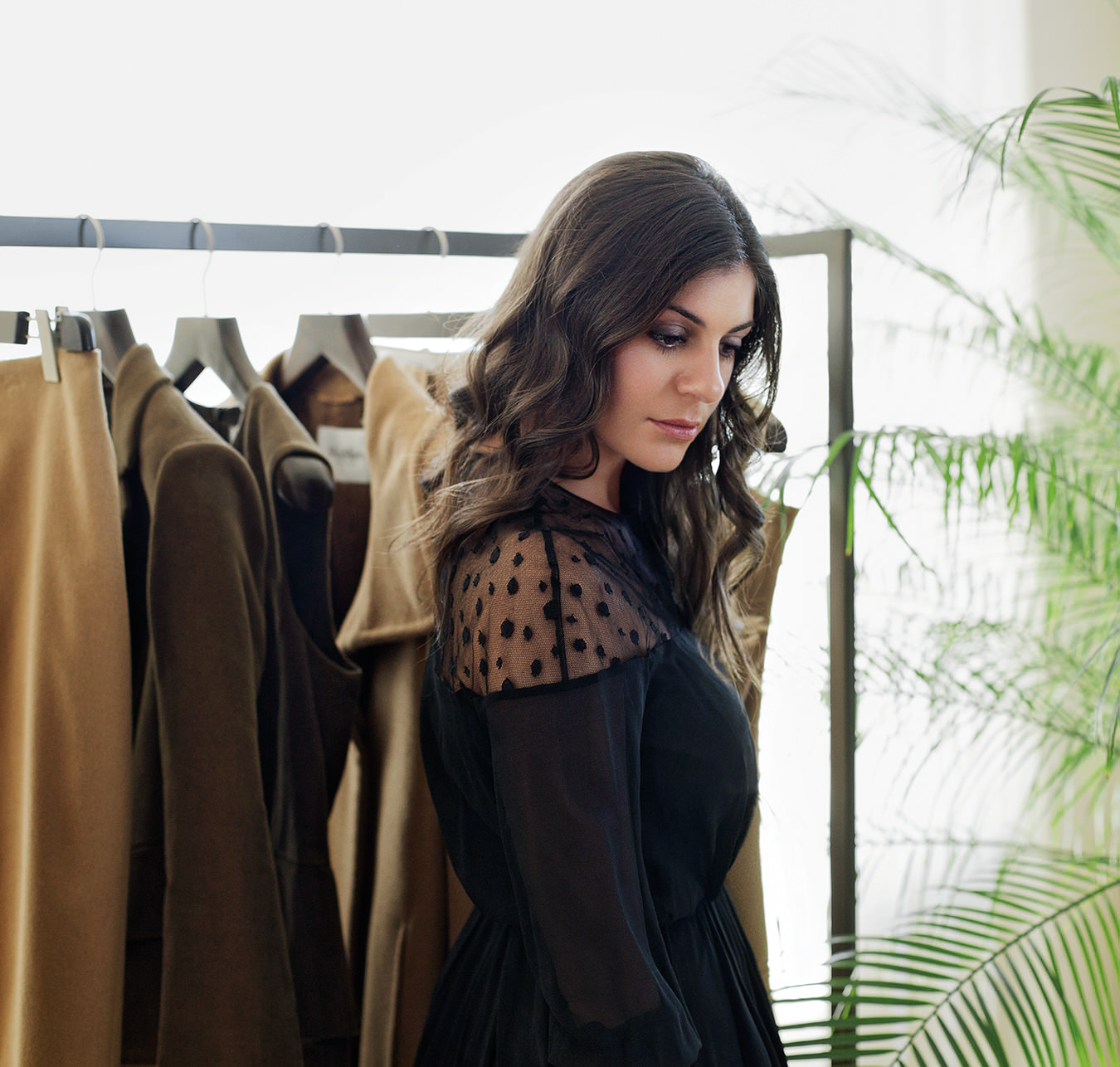
Maria Giulia Maramotti
Max Mara's next generation.
Twisting around in her chair, Maria Giulia Maramotti reveals the words “Gimme Shelter” on the nape of her neck, a tribute to her style icon, Keith Richards. “I love the way his hair, rings, and tattoos show his strong personality,” the statuesque, soulful-eyed brunette enthuses. “In my free time, I’m a little bit like him, in jeans, maybe with a nice blazer, but very relaxed, with lots of rings and necklaces. You know, wild hair and no makeup.” The 28-year-old proceeds to tell (and show) me that she has seven tattoos and is planning one more. “I still have to figure out a place where no one will see it when I’m formally dressed,” she ponders, scanning her body. “I always try not to have them in places you generally notice. In my working life, I wear jackets, so it’s strategic placement.” This sums up Maramotti—a rock-and-roll-loving free spirit who effortlessly balances this with her role as North American retail director for esteemed Italian clothing giant Max Mara.
Chatting with Maramotti feels like having a catch-up with a long-time friend. It’s a scorching summer’s day outside, and we’re perched on cream chairs in a cool-white room on the 21st floor of the Max Mara offices in Manhattan’s Garment District. “I just flew in from Milan,” she says in her lilting Italian accent. “One of my best friends had a wedding there.” Maramotti moved to New York last year—how does the dating scene compare with Milan? “Thank goodness I have an amazing boyfriend, Roberto, in Italy, so I’m fine,” she says, grinning.
It’s easy to forget that this is the granddaughter of one of fashion’s most successful visionaries. The late Achille Maramotti, who died in 2005, pioneered Italian prêt-à-porter fashion when he launched Max Mara in Reggio Emilia in 1951. Tapping into a changing society, he offered high-end manufactured clothes at a time when many style-savvy women still relied on dressmakers. His first collection featured a camel coat (now the brand’s most iconic piece) and a red suit, setting an enduring design blueprint. With a focus on outerwear and suits, the aesthetic was all about precise, clean lines; quality of construction, and classic yet modern style.
Rather than championing a figurehead designer, the focus was on the creative process of the entire design team. Even when notables such as Karl Lagerfeld and Dolce & Gabbana designed for the brand in the 1970s, and Proenza Schouler in the 1980s, they did this anonymously. The Max Mara philosophy was (and still is) about visibility of the brand before individual names. Achille Maramotti took this position because he believed that a collection is never about just one person but is dependent on a production process involving many contributors, from fabric researchers to machinists. “For us, the idea was to create beautiful clothes regardless of who designed them,” says Maria Maramotti. “It’s been our strength for 61 years.”
Today, the fashion group is led by Achille Maramotti’s children: Ignazio, chairman of Max Mara Fashion Group; Luigi, chairman of Max Mara; and Maria Ludovica, Maria Maramotti’s mother and chairman of the group’s Manifatture del Nord. The empire has 2,334 stores in more than 100 countries, with an aggregate turnover of €1.26 billion ($1.55 billion Canadian) in 2010, and more than 5,000 employees worldwide. More than 60 collections are produced every season for the group’s nine brands: Max Mara, Sportmax, Weekend Max Mara, Max&Co., Marella, Marina Rinaldi, iBlues, Pennyblack, and Persona, plus there are accessories and fragrances. The company is not resting on its laurels, with expansion planned in China, Brazil, and India. Although 80 per cent of Maramotti’s time is spent stateside, she is very involved with the new stores. “I’m going to China next week because we’re opening a flagship store in Hong Kong, which will be one of the largest in the world,” she says. “We want to underline our presence in China’s market.”
“The idea of staying modern lies in understanding women’s lifestyle,” says Maramotti. “In the sixties, women had time to get changed for dinner, but now they don’t. They need to be properly dressed from morning to evening.”
While sticking to the principle of timeless elegance, Max Mara has also stayed current with the development of new lines, such as Weekend Max Mara in the 1980s, which distinguished between the new career woman’s work wardrobe and leisure wear. “The idea of staying modern lies in understanding women’s lifestyle,” says Maramotti. “In the sixties, women had time to get changed for dinner, but now they don’t. They need to be properly dressed from morning to evening. Our success as a fashion brand is staying relevant to women’s lifestyles. We have a specific market—we’re not haute couture.”
At the same time, advertising has kept the brand’s image current. Campaigns have been shot by the world’s top photographers, including Peter Lindbergh in the 1980s, Richard Avedon and Steven Meisel in the 1990s, and Craig McDean in the 2000s. For fall/winter 2012, Mario Sorrenti brings to life a Max Mara collection channelling the Bauhaus and the 1920s, with nods to Fritz Lang’s Metropolis and Rainer Werner Fassbinder’s sailor film Querelle. Think military-style coats (well-crafted outerwear is still the brand’s signature), caps with alligator peaks, cocoon shapes, and a splash of nautical chic with striped sweaters. As you’d expect from the brand, luxe textures include cashmere, angora, and crêpe wool, in a palette of khaki, camel, black, silver-grey, and houndstooth. We even see classics such as the camel coat reinvented as a jumpsuit—and there’s a new accessory addition, the crocodile-print Ali bag.
It is this focus on innovation-meets-tradition that keeps the fashionable flocking. Hollywood darling Emma Stone recently donned a checked sweater, and wool and leather cap, both from Max Mara fall/winter 2012, on her British Vogue cover debut. She is often spotted in her beloved camel coat in New York. “I love her style,” says Maramotti. “I’m proud to see her in our coat because it’s our trademark.” Other fans include Michelle Obama, Katie Holmes, and Jessica Alba. “Having young ambassadors is an important part of our strategy,” says Maramotti. “Max Mara has always been perceived as a beautiful, classic brand, but when you see these young, fashion-forward women, you’re like, ‘That’s really cool on her.’ ” On Maramotti’s to-dress wish list are Cate Blanchett, Kate Winslet, and Kate Middleton.
For Maramotti, joining the family empire was a natural step. “You cannot separate the Max Mara concept from my family because everybody works there. That was the main topic at the dinner table,” she says of her childhood. Some of her earliest memories are of doing her homework at her mother’s office and meeting her grandfather for lunch in the work canteen. Did she feel pressure to enter the family business? “Not at all,” she replies. “I always had the passion.”
Indeed, her enthusiasm for fashion was sparked at a young age. At eight, she fondly remembers rooting through her mother’s closet and twirling around in the graceful couture gowns. “They were just beautiful,” Maramotti reflects dreamily. “That is one of my first fashion memories.” She attended her first Max Mara fashion show in Milan at 13. “I was backstage, so I felt a lot of emotion and also pride.”
After graduating with a master’s degree in finance from Milan’s Bocconi University, Maramotti joined the company in 2008—but not in the role you might expect for an heiress to a billion-dollar empire. At 23, she began on the shop floor as a sales assistant in a Milan boutique. “At the beginning, I was like, ‘Seriously—you want me to go into sales? Are you kidding me?’ My mother looked at me and said, ‘This is the biggest favour we can do for you,’ and it turned out to be the truth. Coming into the retail business—and I’m very young for where I am—I’ve learned a lot by starting from the beginning. I’ve had constant growth and it has turned out to be the key to my success as a businesswoman.”
Maramotti is all fired up for her new retail director role. Much of her time is spent travelling to stores and she has ambitious plans for the brand. “I strongly believe in organic growth,” she says, explaining that they have 16 stores in the United States. “I like to call my company a quiet giant.” In Canada, Max Mara has boutiques in Vancouver, Montreal, and Toronto, as well as seven concessions. “We just opened a flagship in Toronto, so I’m there once a month,” she says.
When not working, her signature style is “very relaxed,” she says. “I’m kind of a hippie—sometimes I like to get dressed up for the night in a beautiful red dress and high heels, but normally I’m in my denim shorts, white shirts, and ballet flats.” Refreshingly, she doesn’t always get it right. “Fashion mistakes? No. Fashion crazy? Yes. Last year I bought this backless, super-sexy dress in turquoise jersey. I’ve never worn it. It’s gorgeous but too much.” Along with a collection of 70 pairs of shoes, her wardrobe treasures include a Balenciaga leather jacket (“totally me”), a vintage Valentino gown, and a camel Max Mara coat (“still one of my masterpieces”).
“My mother taught me that perfect style is being coherent with your lifestyle,” says Maramotti. “The concept of fashion being something that is very real.”
“My mother taught me that perfect style is being coherent with your lifestyle,” says Maramotti. “The concept of fashion being something that is very real.” Then she throws in: “But she wasn’t very fond of my tattoos!” Maramotti got her first tattoo, a sun, at 18. “I told her it was fake, and after the third summer of seeing it, she looks at me and she’s like, ‘Okay, it’s your body, do what you want with it.’ She’s very laid-back.” Since then, Maramotti’s other tattoos include a gun on her bicep (“a rock-and-roll symbol”) and the word “Crossroads” on the inside of her wrist. “I’m a big fan of blues music,” she explains.
How does she reconcile this personal side with her professional role? “For sure, I have interests that are not exactly what you would expect from someone like me,” she says, shrugging. “But I’m very strict and precise in my work life, which is probably why in my private life, I’m a bit of a rebel.” She adds, “That is my way to escape.” And when it comes to her personal style, she offers, “Max Mara is, in a way, an edgy brand because you dress this very classical woman but very strong. She dresses for herself.”
Maramotti’s new role has meant stepping into the spotlight, but “it’s just part of my job,” she says. “I go to parties but only when necessary.” People sometimes have a misconception of how she’ll be when they meet her. “I’ve been told, ‘You’re so normal,’ but I like the idea of sending out a message that yes, maybe I’m from a powerful family in the fashion business, but that doesn’t mean you have to be glamorous. My family and I work a lot, like crazy, and enjoy our life in a very uncomplicated way.”
Aside from music, her other passion is sailing, and her perfect day would be on a boat, enjoying a simple fish dinner, and listening to a guitar under the stars. On board, you’ll find her in her weathered Guatemalan kaftan, over denim shorts and a tee. “The only thing I love as much as my job is sailing,” she declares. “I have this dream to sail around the world. I’m a bit of a gypsy. It’s part of my energy and I always need to be moving. When I sail, I feel at peace and a connection to nature.”
While she enjoys living in the Big Apple (“I love its energy and how you feel that anything is possible”), Maramotti hasn’t ruled out relocating to some far-flung locale such as Brazil or China. “There are so many markets that are important for the brand,” she muses. The rest of her family is in Reggio Emilia, but her character thrives on change. “I’m able to say, ‘Okay, let’s go.’ ”
Maramotti feels a great responsibility to continue her grandfather’s legacy. “For him [Achille], it wasn’t about money or power—it was about believing in the idea of entrepreneurship, and that is one of the biggest lessons I’ve learned from him,” Maramotti reflects on her grandfather, an intensely private person (the whole Maramotti family is still one of the most discreet in Italian fashion today). “It doesn’t matter how much money you have, it’s the way you do business. You believe in what you do and the people that work with you.” Maramotti and her nine cousins “get on very well, and communicate and share the responsibility.” This is why she is determined to keep the company privately owned. Part of the success of Max Mara has been that without outside investment, they have developed the business in line with their own ethics and corporate values. “One of my missions as a third-generation representative is to do as much as possible to stop it from becoming public,” she says. “Family is the strength of our company so far.”
Very much her own woman, Maramotti is keeping her own—just like her grandfather. When he founded Max Mara at just 24, he turned his back on a law career and instead followed his passion for dressmaking. He inherited this passion from his mother, Giulia Fontanesi Maramotti, who ran a tailoring school, and great-grandmother Marina Rinaldi, who owned an atelier in Reggio Emilia in the 1850s. Throughout his rise to success and fortune, he stayed true to himself and his family values, and in doing so was a trailblazer of his time. “It’s about working hard and putting all your energy and heart into what you do,” Maramotti says of the values her grandfather instilled in her. Whether jet-setting to store openings around the world or sailing the high seas, Maramotti never forgets her family’s roots. She has an unwavering moral (and personal style) compass, and she is fearlessly upholding the Max Mara legacy in her own unique way.
Runway photos provided by Max Mara.




